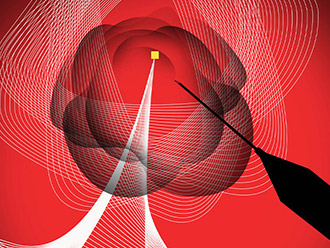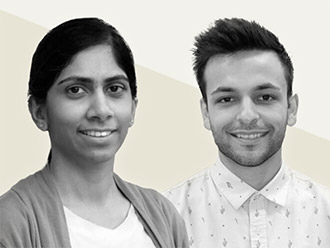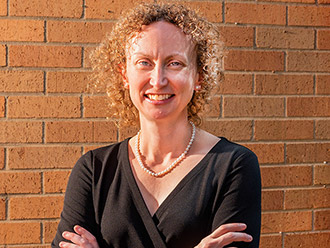Kynadi Harris likes to set people on fire. As a science ambassador at UTA, she gets paid to do it. A performance troupe composed of the College of Science’s best and brightest, UTA’s science ambassadors infuse classroom lessons with theatrical flair, providing dramatic chemistry and physics demonstrations to K-12 students.
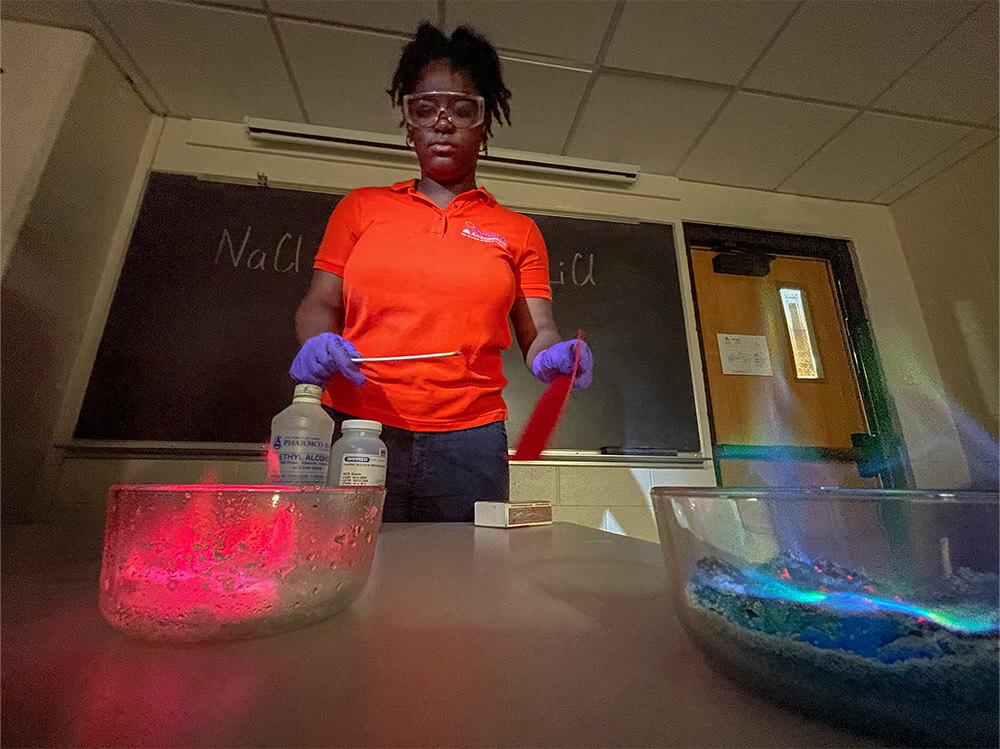
Kynadi Harris
“Don’t try this at home,” Harris stresses as she and other student ambassadors progress through exciting displays of chemical reactions, well-timed explosions, and up-close-and-personal pyrotechnics.
Once per show, student spectators are asked to nominate their favorite teacher for a special experiment. Combining water and dish detergent, an ambassador fills a bucket with bubbles and asks the teacher to scoop up a handful. Striking a match, the ambassador sets fire to the soapy solution in the teacher’s hand. Accompanied by a soundscape of gasps and giggles, the flame grows, then fades, leaving the teacher with a warm but unharmed palm.
“No one is injured, and the students are thrilled to watch their teacher ignite,” Harris says.
The exciting display of science couldn’t come at a better time for these students. Youth interest in STEM subjects steadily declines throughout K-12 school years, according to a study published by researchers at Oregon State University. Although young children initially show enthusiasm for a variety of STEM topics, their curiosity fades year after year. Programs like the one offered by UTA’s science ambassadors intervene when students are at risk of turning their backs on science and math.
“We understand that students may not remember the complex explanations behind our demonstrations, but they will remember how they felt,” says Greg Hale, assistant dean of the College of Science and the program’s co-founder. “We hope to spark in them the same passion for science that our students and professors have.”
Helping young students find that spark has become a national imperative. A recent study by the National Science Board reported that the United States is experiencing a shortage of STEM-trained professionals, leaving the nation’s workforce in a vulnerable position when it comes to technological and scientific innovation.
According to the National Science Foundation, by 2026, science and engineering jobs are projected to grow by 13% compared with 7% growth in the overall U.S. labor pool. As demand grows, the need to engage America’s youth in high-quality STEM education and encourage them to pursue related careers becomes even more vital.
Before the outbreak of COVID-19, the science ambassadors astonished 13,000 elementary, middle, and high school students annually, performing in English and occasionally in Spanish on UTA’s campus and at Title I schools. To accommodate social distancing, the show moved online for most of 2020 and 2021, but the team expects a relaunch of in-person performances as soon as safety protocols allow.
For Shundreka Lanier, program manager of the science ambassadors, the most rewarding part of any show is watching students’ attitudes transform.
“When middle school students come to a performance, they plant themselves in the back row because that’s where the cool kids sit,” Lanier says. “I tell them to move to the front because that’s where the college kids sit. They usually have an attitude, but once the show starts, their faces light up.”
Seeing Is Believing
Women make up nearly half of the U.S. workforce but only account for 27% of workers in STEM careers, according to Census Bureau data. Minerva Cordero is on a mission to change that.
Dr. Cordero, professor of mathematics and senior associate dean for research and graduate studies in the College of Science, was one of 122 women featured as 3D-printed statues in the #IfThenSheCan exhibit at NorthPark Center in Dallas. She was chosen for her innovations in modern geometry and more than a decade of outreach to stimulate young girls’ interest in mathematics.
“A woman’s perspective is vital to any scientific process. Every experiment, design, or research investigation needs a diversity of opinions and lived experiences to achieve the broadest possible result.”
A 3D-printed statue of mathematics Professor Minerva Cordero for an If/Then exhibit.
She says the purpose of the exhibit is not only to celebrate the accomplishments of contemporary female scientists, engineers, and innovators, but also to influence young women to consider similar career paths.
“If girls witness successful women who enjoy careers in science, technology, engineering, and mathematics, then they will be more likely to pursue opportunities in STEM disciplines,” Cordero says. “The If/Then philosophy is ‘seeing is believing.’ The exhibit is meant to inspire young women to put themselves in the scientists’ places and think, ‘That could be me one day.’”
She emphasizes that an important part of recruiting young women to career paths in science is that “seeing is believing” starts at home.
“I often ask parents to imagine that their daughter is a scientist, an engineer, or a doctor because their thoughts will influence her opinion of her own abilities. The truth is that their daughter can be anything she can imagine, and parents have a role to play in supporting her imagination.”
Cordero, a first-generation college student from a financially humble family, wants girls and young women to know that their talents are indispensable to advancement and innovation in the fields of science and engineering.
“A woman’s perspective is vital to any scientific process,” she says. “Every experiment, design, or research investigation needs a diversity of opinions and lived experiences to achieve the broadest possible result.”
Quantum Teaching
When Karen Jo Matsler walked into the Perimeter Institute for Theoretical Physics, she encountered the mind-bending laws of quantum science for the first time. She had no idea that what would happen next would eventually lead her to the White House.
After attending the institute’s lectures in quantum computing, Dr. Matsler, a physics instructor with decades of experience in secondary and postsecondary education, felt an urgency to share what she had learned with other teachers.
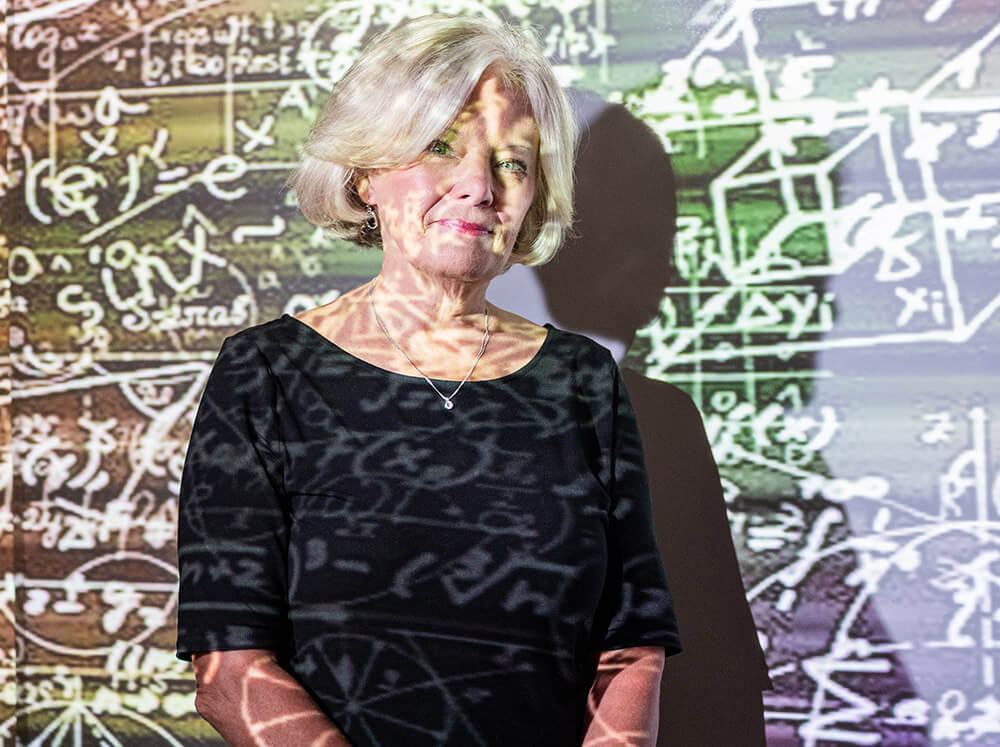
Karen Jo Matsler, assistant professor of practice in the College of Science.
“I had been active in teaching and professional development for more than 25 years and had never taught quantum,” she says. “If that was the case for me, I knew that there would be many other science teachers who weren’t familiar with quantum principles either.”
Quantum information science is an interdisciplinary field that draws from information theory, computer science, and quantum mechanics to process information in novel ways. Quantum principles impact contemporary communication methods, technology, innovation, health care, issues of national security, and more.
Recognizing a national lack of secondary quantum education, Matsler began independent study of quantum information through seminars and classes led by industry professionals. Learning from experts, she developed workshops to introduce teachers like herself to the complexities of the field.
This year, Matsler and colleague Ramon Lopez, professor of physics, received $998,448 from the National Science Foundation to offer one of the country’s first nationwide quantum education initiatives for secondary teachers.
Due to her efforts, the White House Office of Science and Technology Policy asked Matsler to join a 25-member committee to develop a national strategy for students to engage with quantum science.
While officials at the national level discussed the imperative of a quantum workforce and proposed the launch of quantum research centers hosted by universities, Matsler argued that exposure to quantum information must begin in high school classrooms.
“Our government leaders are correct; we need to train university students and members of the workforce in quantum skills,” she says. “But we have to establish a pipeline to feed into those programs. If students have never heard of these concepts before they enter college, they likely won’t choose to study them at advanced levels.”
Matsler’s efforts to equip teachers don’t stop at quantum education. When she’s not lecturing on leading-edge scientific theory, she’s preparing science majors to become top-notch educators.
For Matsler and Dr. Hale, the answer to the nation’s STEM workforce challenge is found in programs that train highly qualified science and mathematics teachers—like the science-educator degree program at UTA, UTeach Arlington.
“UTA’s program emphasizes studentcentered lesson planning. It’s a process of guided inquiry.”
Parvinder Singh demonstrates an experiment in his high school classroom lab.
“Many teachers certified for STEM teaching in Texas have minimal amounts of college coursework in STEM disciplines,” says Hale, who is co-director of the program. “The best-prepared teachers have deep knowledge of their disciplines and excellent STEM-specific pedagogical skills. Our graduates leave UTA prepared to become first-class educators as a result of their STEM degrees and the exemplary pedagogical preparation they received.”
Data collected from the degree program’s 10-year history demonstrates how College of Science graduates are helping to close the gap in the nation’s STEM-talented workforce.
With more than 240 UTeach graduates, the College of Science impacts 20,000 students each year. Sixty-one percent of the program’s educators are teaching in K-12 schools with majority low-income populations.
Economically disadvantaged students who study under College of Science graduates demonstrate deeper math and science comprehension than their peers.
“Our goal is for our graduates and their students not just to survive, but to thrive,” Matsler says.
Parvinder Singh, who teaches pre-advanced placement and advanced placement chemistry at Seguin High School in Arlington, leans on teaching methods he learned at UTA as he attempts to demystify chemistry for his young students.
“UTA’s program emphasizes student-centered lesson planning,” Singh says. “It’s a process of guided inquiry. As the instructor, I provide students with goals and the steps for how to achieve those goals, then walk them through the process. But the student is encouraged to be self-motivated and move themselves through the steps.”
The impact of Singh’s training is not only evident in improved test scores, but in students’ attitudes as well.
“At the beginning of a semester of advanced chemistry, the students are afraid,” Singh says. “By the end of the semester, they are telling me they want to be chemistry teachers.” uta
